China
Things to DO
Dunhuang
Dunhuang is an oasis city located at the very edge of the Taklamakan Desert.
In ancient times the city was one of key transit junctions on the Great Silk Road. It was this place where the caravan road was
divided into Northern Road, running across the Uyghur and Kirghiz lands and Southern Road running through Tibet and Afghanistan.
Thousands of years hundreds of caravans loaded with various goods from precious stones to cereal crops were passing through Dunhuang.
Furthermore, Dunhuang was considered a cradle of Buddhism in China. From there, Buddhist monks were wandering by the Silk Road
disseminating their teachings among the resident population.
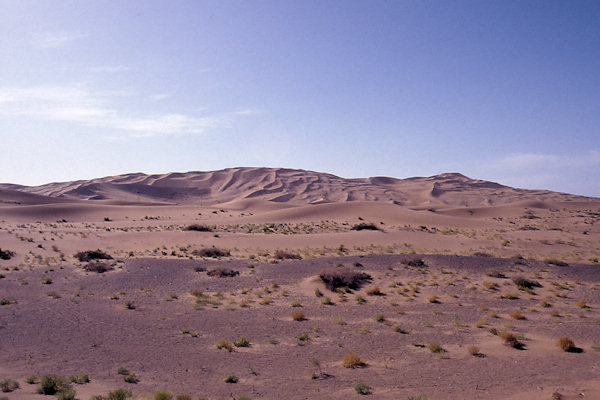 |
|||||
The history of the Mogao Caves begins in 366 AD.
A Buddhist monk by name Le-Tsung saw a shine of Thousand Buddhas on the mountain top during his journey along the Great Silk Road.
Taking this vision as a sign, he went to the mountain and cut through a first cave, where he spent a long time in meditation and prayer.
Over the period of thousands years, Buddhist pilgrims came there to get enlightenment.
Thus over a few centuries, hundreds of gorgeous caves were created which later became one of the world’s most beautiful Buddhist temples.
There are about 492 extant cave-temples ranging in date from the fifth to the thirteenth centuries. During the thousand years of artistic
activity at Dunhuang, the style of the wall paintings and sculptures changed.
The early caves show greater Indian and Western influence, while during the Tang dynasty (618-907 AD) the influence of the Chinese
painting styles of the imperial court is apparent.
See my Painted Statues of Dunhuang-page for a summary.
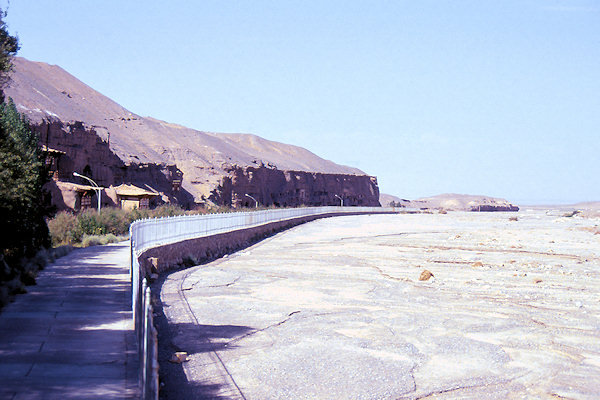 |
|||||
At some point in the early eleventh century, an incredible archive—with up to 50,000 documents, hundreds of paintings, together with
textiles and other artefacts—had been sealed up in chamber adjacent to one of the caves.
In 1900, it was discovered by Wang Yuanlu, a Daoist monk who had appointed himself abbot and guardian of the cave-temples.
Marc Aurel Stein, a British archaeologist and explorer, reached Dunhuang in 1907. He had heard rumours of the walled-in cave and
its contents.
The abbot sold Stein seven thousand complete manuscripts and six thousand fragments, as well as several cases loaded with paintings,
embroideries and other artifacts.
Other expeditions followed and returned with many manuscripts and paintings. The result is that the Dunhuang manuscripts and scroll
paintings are now scattered over the globe. The bulk of the material can be found in Beijing, London, Delhi, Paris, and Saint Petersburg.
Jiayuguan
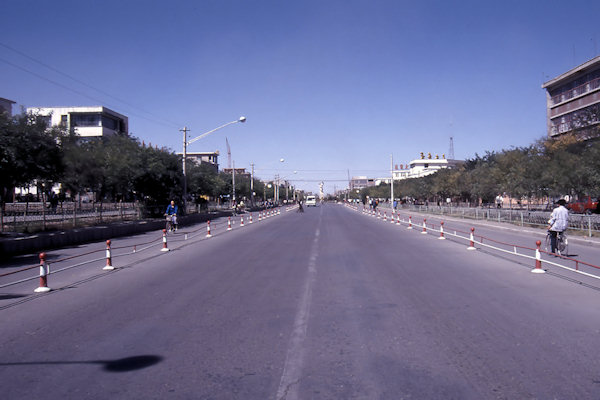 |
|||||
Jiayuguan is a new industrial city.
It was established in 1958 in order to the need of the Jiayugan Iron and Steel Company, the latest iron and steel complex in
Northwest china. Its not an unpleasant town but drab and dusty.
Jiayuguan Fort is the main attraction of Jiayuguan. The fort guards the pass, which lies between the snow-capped Qilianshan peaks
and Black Mountain ("heishan) of the Mazong range.
During the Ming Dynasty (1368–1644 AD) this was considered the terminus of the Great Wall, though crumbling fragments can be
found to the west.
The fort was firts built in 1372, with additional towers and battlements added in subsequent years. The outher wall is about 733 metres in
circumference and almost 10 metres high. Over each gate stand towers which rise to a height of 17 metres, with upturned flying eaves.
On the inside of each gate are horse lanes leading up to the top of the wall. At the fort's four corners are blockhouses, bowmen's turrents
and watchtowers.
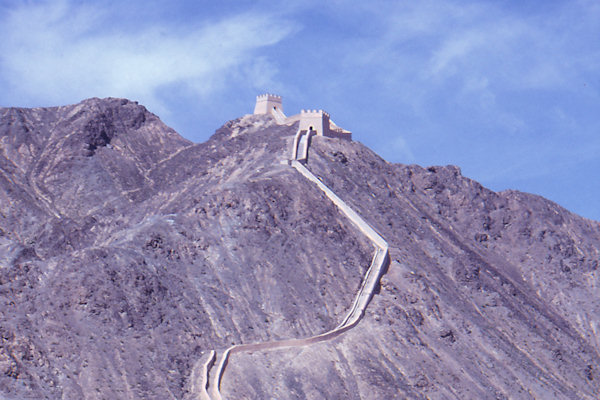 |
|||||
Located about 6.5 kilometers to the northwest of the fort, the Overhanging Great Wall is an important part of the defense
network of Jiayuguan Pass. Built in 1540, it was pretty much crumbled to dust but was reconstructed in 1987.
The Heishan Stone Carvings are scattered on the cliffs along Heishan Valley, 20 kilometers north-west of Jiayuguan.
The Stone Carvings, with 153 pieces in total, were carved during the Warring States period (476-221 BC)
About 20 km east of Jiayuguan you can find tombs that date back to Wei and Jin Dynasties (220-420 AD).
As usual, atraditional fresco tomb was composed of a tomb passage, a tomb gate, a gate tower, a fore chamber, a middle chamber,a rear
chamber and a niche.
The frescos themes were drawn from the daily life, including farming, poultry cultivating, mulberry leaf harvesting, traveling, feasting,
hunting and military drilling.
Lanzhou
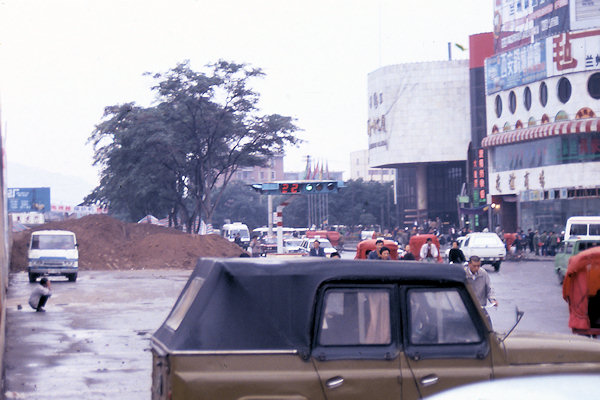 |
|||||
Lanzhou has been an important garrison town and transport centre since ancient times.
The city is in a large valley 1600 metres above sea level.
Situated on the major routes along the Gansu corridor into central Asia, westward into Qinghai and Tibet, south into Sichuan and nort-west
along the Yellow River, Lanzhou was a major centre of caravan traffic into the border regions up until WWII.
Lanzhou's development as an industrial centre began after the Communist victory and the subsequent building of railway lines to link the
city with the rest of the country.
Lanzhou streches for 20km along the southern bank of the Yellow River.
The eastern segment of town, between the railway station and the large Xiguan traffic circle, is the centre of town, and in this area
you'll find most of the tourist facilities.
Xiahe
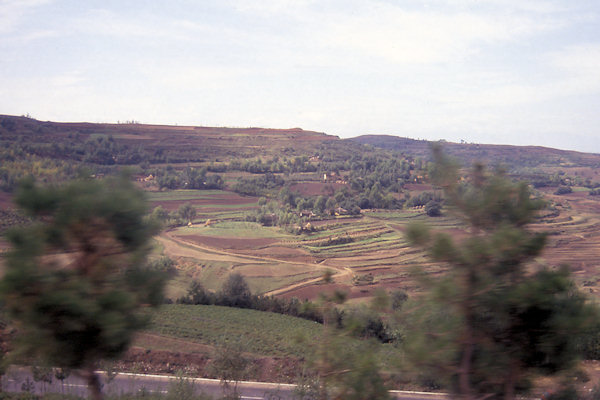 |
|||||
Most people reach Xiahe by bus from Lanzhou.
Sometimes you can book a direct ticket from Lanzhou to Xiahe, but often you will have to first go to Linxia and then change buses.
Linxia once an important town on the Silk Road is located in the valley of the Daxia River a tributary of the Yellow River,
150 km southwest of the provincial capital Lanzhou and a regional centre for the "Hui nationality", i.e. the Chinese-speaking
Muslims.
For centuries, Hezhou/Linxia has been one of the main religious, cultural and commercial centers of China's Muslim community, earning
itself the nickname of "the little Mecca of China".
Linxia is a facinating slice of Arabia with the full Muslim trimmings.
The main attraction of the town are the markets, mosques and people.
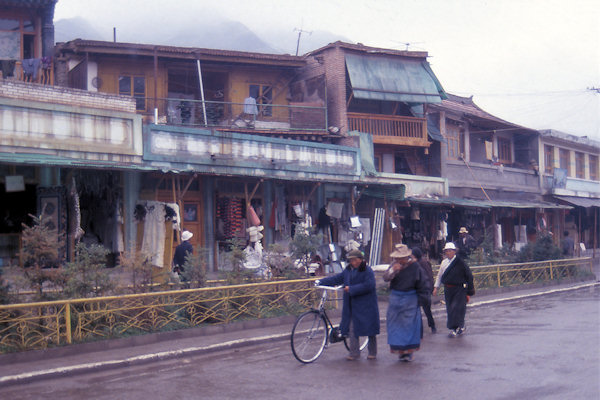 |
|||||
Xiahe is one of the most enchanting places to visit in China, especially if you can't get to Tibet. Outside of Lhasa,
it's the leading Tibetian monestery town.
Indeed, in some ways it's better than Tibet - the people who come here are mostly on pilgrimage and therefore dress in their finest,
most colourful clothing.
The pilgrims, the monks, themonastry, the mountain scenery - when you enter Xiahe, you feel like you've entered another world.
At 2920 metres above sea level, Xiahe is a great place for hiking in clean, peaceful surroundings. Take food, water, warm clothing and
rain gear.
Follow the river or head up into the surrounding valleys, but carry a stick as dogs are a serious problem.
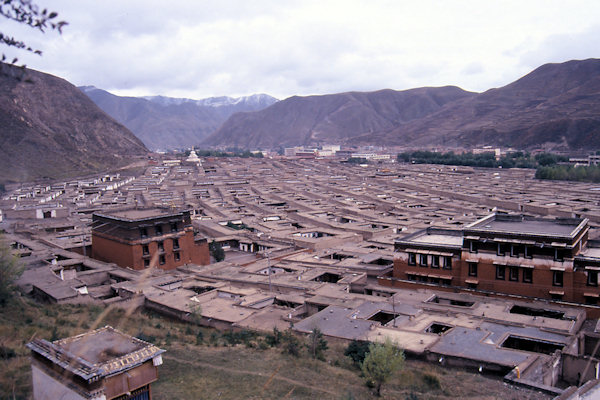 |
|||||
The religious activity is focused on the Labrang Monestry, one of the six major Tibitian monastries of the Gelukpa
(Yellow Hat sect of Tibetan Buddhism).
The monastry was built in 1709 by E'angzongzhe, the first-generation Jiamuyang (living Buddha), who came from the nearby town of
Ganjia.
The monestry contains five institutes, numerous temple halls, living Buddha residence and living quarters for the monks.
At its peak the monastry housed nearly 4.000 monks. Their ranks where depleted during the Cultural Revolution, but are slowly recovering
and there are about 1.300 today.
In april 1985 the Insitute of Esotoric Budhism was razed in a fire caused by faulty electrical wiring. Apparently the fire burnt for a
week and destroyed some priceless relics.
As a result of the fire, monks are unwilling to use electric light anywhere in the monastry buildings, so take a torch.
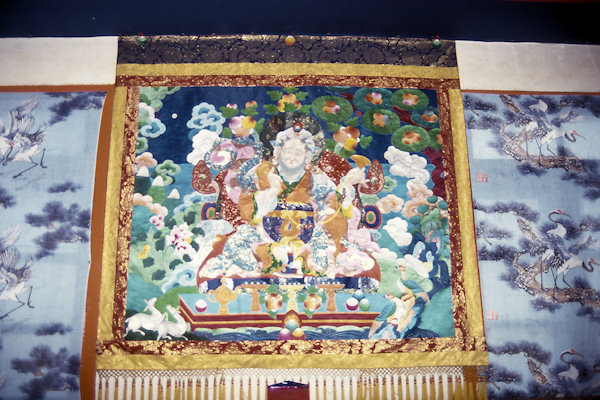 |
|||||
Butter Sculpture is typical Tibetan Buddhist artistic visual impact.
The sculpture is made from mainly butter and other mineral pigments. The butter sculpture mainly describe Buddhsim deities, butter mandalas,
flowers, animals and Buddhist motifs.
Traditionally, butter sculptures are displayed on monastery altars and family shrines as offerings.
Butter sculptures are modeled by hands. Since butter melts easily, monk artists making butter sculptures need to work in cold conditions,
they have to dip their hands into cold water to make their fingers cold enough then can they start to model.
A few tools, such as hollow bones for making long threads and moulds for making leaves and alike, are applied.
The monastery has a butter sculpture museum housing a collection of fine butter sculptures.